This document covers the following topics:
It is often the case that a web application has to display an arbitrary amount of data in a grid control, for instance, the records from a database table. In these cases, it is mostly not efficient to send all data as a whole to the web client. Instead, it will be intended to display a certain amount of data to begin with and to send more data as the user scrolls through the page. To support this, the grid controls in Natural for Ajax support the concept of server-side scrolling and sorting.
The following graphic illustrates the different types of server-side scrolling and sorting that are supported by Natural for Ajax.
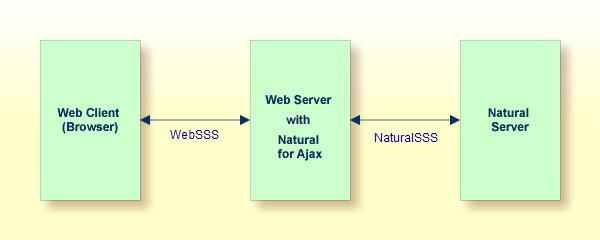
With respect to server-side scrolling and sorting, the following options can be used:
No Server-Side Scrolling and Sorting
The Natural application sends the grid data to the web server as a whole. The web
server sends the grid data to the web client (browser) as a whole.
Advantage: Neither the web server nor the Natural application are involved in the process of scrolling and sorting. As long as the user only scrolls and sorts, no round trip from the web client to the web server or to the Natural server is necessary.
Disadvantage: A round trip between web server and Natural server that is triggered by other user actions transports the entire grid data.
Web Server-Side Scrolling and Sorting (WebSSS)
The Natural application sends the grid data to the web server as a whole. The web
server sends the grid data to the web client (browser) in portions.
Advantage: The Natural application is not involved in the process of scrolling and sorting. As long as the user only scrolls and sorts, no round trip from the web server to the Natural server is necessary.
Disadvantage: A round trip between web server and Natural server that is triggered by other user actions transports the entire grid data.
Natural Server-Side Scrolling and Sorting (SSS_N)
The Natural application sends the grid data to the web server in portions. The web
server sends the grid data to the web client (browser) in portions.
Advantage: A round trip between web server and Natural application passes only the visible data portion.
Disadvantage: The Natural application must support the process of scrolling and sorting with a specific application logic.
The decision between these options will often depend on the expected data volume. The application can decide dynamically at runtime which option to use.
The following topics show the difference between these three options
Step 1: The grid is configured at design time to a row count of twenty. The Natural
application sends twenty rows and indicates that no further rows are to be expected
(SIZE=0).
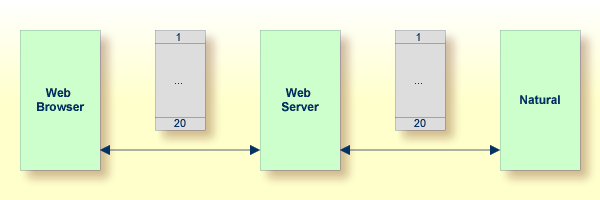
Step 2: When you scroll up and down, no server round trips to the web server or to the Natural application are performed.
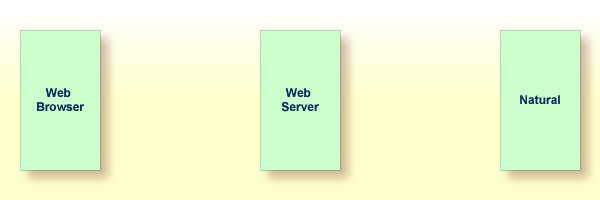
Step 1: The grid is configured at design time to a row count of five. The Natural
application sends twenty rows and indicates that no further rows are to be expected
(SIZE=0).

Step 2: When you scroll up and down, the web browser requests additional records from the web server There are no server round trips to Natural.
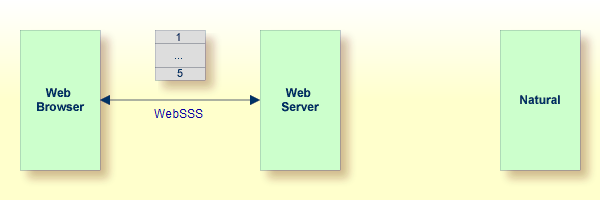
Step 1: The grid is configured at design time to a row count of five. The Natural
application sends five rows and indicates that further rows are to be expected
(SIZE=20).
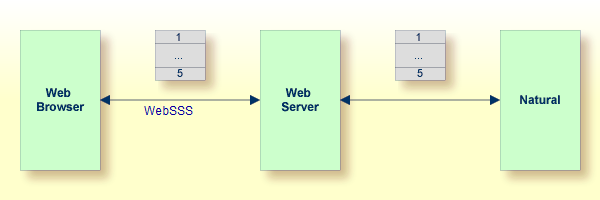
Step 2: When you scroll up and down, the web browser requests additional records from the web server. The web server requests additional records from the Natural application.
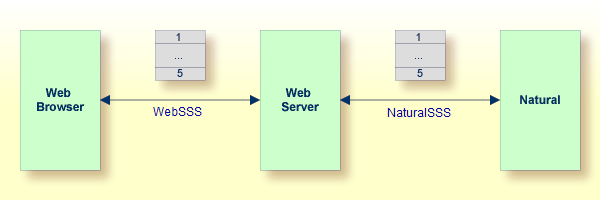
The Natural application can dynamically decide at runtime which option of server-side scrolling and sorting it wants to use. This can depend on the number of records contained in a search result.
If the application does not want to use server-side scrolling and sorting at all, it sends as many rows to the web browser as the grid is configured to hold, or it sends fewer rows.
If the application wants to use web server-side scrolling and sorting, it sends
all available rows and sets the SIZE parameter to zero in the
data structure that represents the grid in the application.
If the application wants to use Natural server-side scrolling and sorting, it
sends only part of the available rows and indicates in the
SIZE parameter how many rows are to be expected
altogether.
The following controls support server-side scrolling and sorting:
Note
For compatibility reasons with earlier versions of Natural for Ajax, you have to set
the natsss property of NATPAGE to true in order to activate
server-side scrolling and sorting for the controls ROWTABLEAREA2 and MGDGRID. If this
property is set to true, for all instances of these grid controls on a page, the necessary
data structures are generated into the Natural adapter interface.
If you use the TEXTGRIDSSS2 control or if you use the ROWTABLEAREA2 or MGDGRID control
and have set the property natsss to true for the page, the
following additional data structure is generated into the adapter interface for each
instance of these controls. This data structure is used to control the scroll and sort
behavior at runtime.
1 LINESINFO 2 ROWCOUNT (I4) 2 SIZE (I4) 2 SORTPROPS (1:*) 3 ASCENDING (L) 3 PROPNAME (U) DYNAMIC 2 TOPINDEX (I4)
The name of the data structure is derived from the name of the variable that is bound to
the grid. In this example, the variable LINES had been bound
to the grid. Therefore, the name LINESINFO was generated.
With each event that is related to scrolling and sorting, the application receives the
information how many rows it should deliver at least (ROWCOUNT) and the index
of the first record to be delivered (TOPINDEX).
In SORTPROPS, the application receives the information in which sort
sequence the records should be delivered and by which columns the records should be
sorted.
On the other hand, the application itself can specify a sort sequence (also using multiple sort criteria) and indicate this sort sequence by filling the structure with the desired sort criteria.
If web server-side scrolling and sorting is used, the specified sort sequence is automatically created on the web server.
If Natural server-side scrolling and sorting is used, the application itself must provide the records in the specified sort sequence.
With the TEXTGRIDSSS2 control, the first three specified sort criteria are automatically indicated in the column headers of the grid.
With the ROWTABLEAREA2 control, the first specified sort criterion is automatically indicated in the column headers of the grid. If more sort criteria are to be indicated, the application should provide custom grid headers.
In SIZE, the application can indicate whether the delivered amount of rows
represents all available data (SIZE=0, no Natural server-side scrolling), or
whether there are more rows to come
(SIZE=total-number-of-records, Natural
server-side scrolling).
When Natural server-side scrolling is used, the application will, for instance, hold the available rows (mostly the result of a database search) in an X-array, sort this X-array as requested and deliver the requested portion of rows. However, other implementations and optimizations are possible, depending on the needs and possibilities of the application.
When the application supports the selection of grid items, the application must take care
to remember the selected state of each item when the TOPINDEX changes.
The ROWTABLEAREA2 control can also be configured as a tree control, where each row
represents a tree node. In this case, the data structure that supports server-side
scrolling contains one more field, DSPINDEXFIRST.
1 LINESINFO 2 DSPINDEXFIRST (I4) 2 ROWCOUNT (I4) 2 SIZE (I4) 2 SORTPROPS (1:*) 3 ASCENDING (L) 3 PROPNAME (U) DYNAMIC 2 TOPINDEX (I4)
The need for this additional control field comes from the fact that a tree can contain hidden items.
The rows sent by the Natural application must always start with an item at level one. The
additional field DSPINDEXFIRST is provided because the visible part of the
tree can start at a node with a level greater than one (a subnode). In
DSPINDEXFIRST, the application must indicate the index of the first visible
row within the rows sent from Natural.

The top nodes of the tree are open and the user scrolls down as shown below:

The Natural application is supposed to send data starting with a top node. In our
example, this is the node named toptext_0. But the first
visible child node would be childtext_0.2. This means that
among the sent items, the first three items are hidden. The application sets the value for
DSPINDEXFIRST to "3" when sending the data.
In order to support server-side scrolling and sorting, an application must handle a number of related events properly. The events are described with the corresponding controls. Examples on how to handle the events are provided in the Natural for Ajax demos.